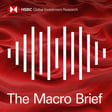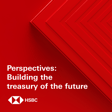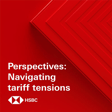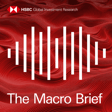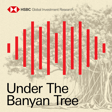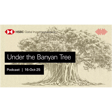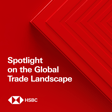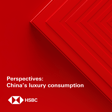Become a Creator today!Start creating today - Share your story with the world!
Start for free
00:00:00
00:00:01

Exploring opportunities in emerging markets
Emerging markets are experiencing challenges in the current political and economic environment. We take a detailed look at some of these challenges, what they mean for this assets class right now, and some of the silver linings. We explore the impact of rising US interest rates and inflation, the role of emerging markets in the sustainability agenda and look at one bright spot in the current moment – India.
Hosted on Acast. See acast.com/privacy for more information.
Transcript
Introduction to HSBC Global Viewpoint
00:00:00
Speaker
This is HSBC Global Viewpoint, your window into the thinking, trends and issues shaping global banking and markets.
00:00:09
Speaker
Join us as we hear from industry leaders and HSBC experts on the latest insights and opportunities for your business.
Panel Introduction by Murat Tulgan
00:00:18
Speaker
Thank you for listening.
00:00:23
Speaker
My name is Murat Tulgan.
00:00:24
Speaker
I'm the global head of emerging markets research.
00:00:27
Speaker
Let me introduce the panel first.
00:00:28
Speaker
So we have Mr. Michael Story from PIMCO Group.
00:00:31
Speaker
He's the senior vice president and emerging market product strategist.
00:00:36
Speaker
I have Mr. Uday Patnaik, who is the head of emerging markets debt at Legal and General Investment Management.
00:00:42
Speaker
I have Mr. Devon Kalou.
00:00:43
Speaker
He's the global head of public markets and global head of equities in Aberdeen.
00:00:48
Speaker
We have Mr. Praveen Jagwani from Unit Trust of India.
00:00:52
Speaker
Internationally, he's the CEO and solely focused on investments in India.
00:00:57
Speaker
So gentlemen, thank you very much for joining me.
00:00:59
Speaker
So let's
Challenges in Emerging Markets
00:01:00
Speaker
kick off the panel.
00:01:00
Speaker
We have a relatively short time to talk about emerging markets, which is a massive topic.
00:01:04
Speaker
But let me kick off from the beginning, sort of the top down, big picture, global macro environment.
00:01:11
Speaker
I've been doing this business for about 25 years in various guises and last eight years and I'm a strategist.
00:01:17
Speaker
It's fair to say, at least from my perspective, this is probably the most challenging or as challenging as it could get in terms of the external backdrop from slowing global growth, slower China growth to rising inflation, higher global rates, withdrawal of liquidity.
00:01:32
Speaker
Stackflation is a sensational headline.
00:01:35
Speaker
We don't get it very often.
00:01:36
Speaker
We tend to brand it more like a worsening in EM's growth inflation mix.
00:01:41
Speaker
which is not great.
00:01:43
Speaker
And I think that's also relevant for developed markets as well.
00:01:46
Speaker
It's not only global cost of funding is rising, but global liquidity is also falling.
00:01:50
Speaker
And we got lots of volatility across asset classes, a stronger dollar and volatile commodity markets.
00:01:55
Speaker
So clearly no major anchor for EM externally, if I dare to say, if anything, the drags are getting very, very powerful.
00:02:03
Speaker
particularly growth where the financial conditions have been tightening for EM for some time.
00:02:09
Speaker
The Fed started hiking rates in March.
00:02:11
Speaker
A lot of emerging markets were hiking interest rates for more than a year.
00:02:15
Speaker
Obviously, falling equity markets and credit growth getting slower, if not negative in certain cases, tightens financial conditions.
00:02:22
Speaker
not a great picture for future growth.
00:02:24
Speaker
And on inflation, I'd say EM is particularly vulnerable when it comes to the staple subsistence items, especially food and energy, because they have a much larger share in EM's consumption basket compared to the developed markets, especially food, which occupies somewhere between 20 to 45%, depending on the country.
00:02:43
Speaker
And it's quite sticky.
00:02:44
Speaker
But not everything is in doom and gloom.
00:02:47
Speaker
I'd say, you know, contrary to the fundamental backdrop, the technical picture is actually pretty supportive for EM, which I mean the valuations, because now we're talking about stagflation in the context of developed markets, but EM has been undergoing stagflation influences.
00:03:03
Speaker
for nearly a year, pretty much since the second half of this year.
00:03:06
Speaker
And if you look at the pricing, if you look at the spread on external data, if you look at local markets rates, if you look at the equities like universal price earnings ratio, earnings yield, these are back to 2018 levels.
00:03:19
Speaker
Last time we saw this double dammy of Fed hiking more than expected and balance sheet reduction.
00:03:24
Speaker
So I'd say valuations are quite compelling actually, and in certain cases really, really compelling.
00:03:30
Speaker
And then the positioning has been reduced significantly pretty much across the board, more so for local debt.
00:03:36
Speaker
Every quarter HSBC conducts what we call an emerging market sentiment survey, where we canvass views of institutional investments from all walks of life, asking them questions about market and macro trends, but also asking cash levels and how they're intended to use that cash.
00:03:51
Speaker
And it's been five quarters that cash levels have been constantly going higher.
00:03:56
Speaker
In the last survey that we released in March, 25% of the investors have more than 10% cash in their portfolio as an issue of asset management.
00:04:03
Speaker
That is a very high number.
00:04:05
Speaker
So what I'm really trying to say, we got a super challenging, fundamental, external picture.
00:04:12
Speaker
We got a supportive, technical picture.
00:04:14
Speaker
How do we square
Opportunities and Supportive Factors
00:04:15
Speaker
this?
00:04:15
Speaker
Well, from our side, our humble view is it's not top-down.
00:04:19
Speaker
Top-down is very difficult.
00:04:21
Speaker
We look at bottom-up opportunities.
00:04:22
Speaker
We try to side...
00:04:25
Speaker
still countries who are the beneficiary of elevated commodity prices, commodity producers and exporters.
00:04:30
Speaker
But that by itself is not enough.
00:04:32
Speaker
We also would like to see an effort to get ahead of the inflation curve, to arrest inflation pressures, prudent policies, be it monetary tightening,
00:04:41
Speaker
in the case of Latin American countries, for instance, which have been rather aggressive in their rate hikes and for quite a long time, or be it responsible fiscal policies, like in the case of GCZ countries, where they're actually rolling out fiscal reform, tax reform, VAT, corporate tax, et cetera.
00:04:57
Speaker
Those are our preferred regions, GCC in particular, more perhaps for equities and credit and then some effects and maybe local markets at some stage in Latin America.
00:05:08
Speaker
But I have to say, not spoiled for choice.
00:05:11
Speaker
It is a difficult backdrop and we try to be a lot more selective and try to take calculated EM
Fixed Income Strategies by Michael
00:05:17
Speaker
risk.
00:05:17
Speaker
So why don't I now turn to Michael.
00:05:20
Speaker
who actually has a very broad remit across the whole fixed income spectrum.
00:05:24
Speaker
And Michael, if you could touch upon sort of your general approach to the asset class, how do you rate local versus external?
00:05:32
Speaker
How do they stack up?
00:05:33
Speaker
Liquid versus illiquid, you know, private credit, maybe if there's time on frontier markets.
00:05:37
Speaker
So lots to go through, Michael, over to you.
00:05:39
Speaker
Thank you very much.
00:05:40
Speaker
This is a very difficult backdrop.
00:05:42
Speaker
And a lot of times we think in terms of push versus pull factors in EM, the pull factors that are those that are kind of pulling capital into our space, the endogenous factors, and then there's the push factors that are exogenous from outside the asset class.
00:05:55
Speaker
And obviously allies are in the Fed, allies are on inflation and other kind of global monetary condition metrics.
00:06:01
Speaker
So it's a tough backdrop, but we would completely agree the valuations are very attractive and some of the structural secular
00:06:09
Speaker
Technicals also look very attractive, but this is an acute moment.
00:06:12
Speaker
We're all going through an acute moment.
00:06:14
Speaker
I think in the external space, correct me if I'm wrong, but I think this is maybe the third largest drawdown in the history of the asset class.
00:06:22
Speaker
We can go back to the global financial crisis.
00:06:24
Speaker
We can go back to Asia in 1997, a very, very different landscape then versus now.
00:06:30
Speaker
And yet we've got this massive sell-off.
00:06:33
Speaker
driven by rates, driven by repricing of interest rates, inflation, and global monetary conditions.
00:06:41
Speaker
I think one of the questions that we get a lot is, should we invest in local or should we invest in external?
00:06:47
Speaker
It's a very tough question to get right.
00:06:49
Speaker
In fact, I would say that making that call is inherently a lower Sharpe ratio type of decision.
00:06:54
Speaker
It's a very difficult one to get right.
00:06:56
Speaker
And of course, the last 10 years, maybe even longer, has made that decision even more difficult because local...
00:07:02
Speaker
has been on the back foot.
00:07:03
Speaker
We've seen a dollar bull market for 10, 11 years now.
00:07:08
Speaker
We went from strength to strength when COVID hit and the dollar benefited from a safe haven bid.
00:07:13
Speaker
And so that's something to watch out for.
00:07:15
Speaker
But I would say that generally, we're pretty cautious on local at the moment.
00:07:20
Speaker
We're quite bullish on external, although longer term, I think there's a lot of value to be had on the local side.
00:07:26
Speaker
External is an easy one.
00:07:27
Speaker
You can kind of look at that as a complement, a diversifier to credit, US corporate credit, European corporate credit, securitize.
00:07:34
Speaker
There's been a lot of money flowing into this space for a very long time.
00:07:38
Speaker
And it's a very easy way to complement that or diversify
00:07:42
Speaker
some of the concentrations.
00:07:43
Speaker
It's rare to find an asset class that does not have a trade-off.
00:07:46
Speaker
Normally, if you want to diversify, there's a yield give.
00:07:50
Speaker
Looking at EM external is one of those rare opportunities not to give yield and deconcentrate.
00:07:56
Speaker
On the local side, I think you have to lean in more on the diversification angle.
00:08:00
Speaker
There's a lot of idiosyncrasies.
00:08:02
Speaker
If you look at the 20, 25 countries in the space, they all move quite independently.
00:08:07
Speaker
Even in an environment now where there's kind of this global exogenous shock on inflation and supply chain disruptions.
00:08:12
Speaker
But there is a kind of a lower co-movement.
00:08:16
Speaker
But ultimately, you do need EM currency appreciation to justify the vol.
00:08:21
Speaker
And we have not had that for quite some time.
00:08:23
Speaker
So that's something that we'll be looking for.
00:08:26
Speaker
When we think about asset allocation, I would suggest that there's a better way than thinking about local versus
Risk Factors in Emerging Markets
00:08:32
Speaker
external.
00:08:32
Speaker
That's kind of the top level question.
00:08:35
Speaker
I think the better response is to unbundle or unpack the different risk factors that are embedded in these different asset classes.
00:08:42
Speaker
On the external side, of course, the main risk factor is spread, compensation for credit risk, and then there's US duration.
00:08:49
Speaker
And on the local side, you've got two risk factors that are really driving things, it's currencies and then it's duration, but local duration, very different than the duration on the external side.
00:09:00
Speaker
And the way we would rank order these, and if you think in kind of a terms of a risk parity approach to constructing a portfolio is we would put local duration at the top of the list.
00:09:08
Speaker
It's a very interesting risk factor.
00:09:10
Speaker
I think one of the most underappreciated risk factors that are out there in global fixed income.
00:09:15
Speaker
There are EM countries now that can play the same role that gilts or bunds or US treasuries can play.
00:09:21
Speaker
Bad things happen and there's a rally, not a sell-off.
00:09:24
Speaker
So not just a yield generator, but some kind of a hedge against downside markets.
00:09:30
Speaker
And so it's a really interesting risk factor to consider and we would lean into that.
00:09:33
Speaker
But again, you have to unbundle that from a local bond that has currency exposure as well.
00:09:38
Speaker
Next in line would be spread.
00:09:40
Speaker
Right now, spreads look really interesting.
00:09:42
Speaker
But again, there's this complementary effect that is quite interesting.
00:09:45
Speaker
And then last on the list is currencies.
00:09:47
Speaker
And that's a difficult one to get right.
00:09:48
Speaker
Idiosyncrasy, I think there's a lot of interesting opportunities.
00:09:51
Speaker
But again, it's been a very difficult backdrop.
00:09:54
Speaker
One of the things that we've been doing more is looking at lending opportunities along the liquidity
Private Credit Opportunities
00:10:00
Speaker
spectrum.
00:10:00
Speaker
I think there's been a flood of capital, as we all know, private credit in the US, private credit in Europe.
00:10:05
Speaker
This has been a phenomenon for a very long time.
00:10:08
Speaker
We've not seen the same phenomenon in emerging markets.
00:10:11
Speaker
There is a credit constraint in a lot of countries, not all of them, of course, but there is a credit constraint in a lot of countries, and it's a large effort to intermediate illiquidity.
00:10:22
Speaker
in emerging markets relative to the US and relative to Europe.
00:10:25
Speaker
And so we are moving down the liquidity spectrum and designing vehicles for that.
00:10:29
Speaker
But EM overtook the US as the single biggest pool of credit in the world a number of years ago.
00:10:35
Speaker
It continues to expand.
00:10:37
Speaker
for good reasons, for some less good reasons, but it's the biggest pool of credit in the world now.
00:10:41
Speaker
And I think there's a major kind of miss when you're not considering searching out premiums for illiquidity, which is very orthogonal, uncorrelated to the other risk factors that I mentioned, currencies,
00:10:53
Speaker
duration spread and embedding that in the portfolio.
00:10:56
Speaker
So I think there's a really interesting area there that we could maybe investigate further.
00:11:00
Speaker
Thanks very much, Michael.
00:11:01
Speaker
I think that sets the stage very neatly for the broader fixed income world.
00:11:04
Speaker
I appreciate that.
00:11:05
Speaker
And perhaps as we stay in fixed income, maybe we go into a little more specifics with Uday, perhaps touching upon the picture on external debt, high yield versus RG, supply versus demand across the regions.
00:11:15
Speaker
And how do you think the current US Treasury Board of Tility is spilling over to EM?
00:11:21
Speaker
Thank you Uday.
00:11:22
Speaker
Actually, we're positioned very similarly that we prefer hard currency to local currency, given our view on the U.S. dollar, which is still positive.
00:11:31
Speaker
So I've been investing in emerging markets, fixed income for about 30 years.
00:11:35
Speaker
A lot of people think of this asset class as this homogenous asset class, but it isn't.
00:11:40
Speaker
But in my 30 years, what I would say is the opportunities we're seeing today are fairly unique.
00:11:46
Speaker
I mean, we haven't seen these opportunities since March, April 2020, since COVID.
00:11:50
Speaker
In fact, if you look at the external, the JP Morgan sovereign index, the MB index, the yield is
00:11:59
Speaker
25, 30 basis points away from where we were during COVID, peak COVID on that index.
00:12:05
Speaker
And the spreads over the last 12 years are about the second or third highest, just second to the COVID period.
00:12:13
Speaker
So the opportunities are dramatic from an investing standpoint.
00:12:16
Speaker
Now, there are a lot of ways you can do this.
00:12:19
Speaker
And we have a lot of themes that are running through our portfolios.
00:12:22
Speaker
So number one,
00:12:24
Speaker
We have been underweight duration for quite some time.
00:12:27
Speaker
That said, we're in the process of neutralizing our duration underweight, and we can maybe talk about inflation later.
00:12:34
Speaker
But number two, we have a preference for credits that are commodity exporters, whether it's sovereigns or corporate.
00:12:43
Speaker
So countries like Angola, for example, where debt to GDP two years ago was 130 percent.
00:12:49
Speaker
By the end of this year, expected to be about 55 percent.
00:12:54
Speaker
We like reform stories like Oman, again, where you've got the oil impact.
00:12:59
Speaker
You also have declining debt and strong reform measures.
00:13:04
Speaker
Other reform stories, for example, in India, renewable energy companies, which are offering attractive yields, steel companies in India.
00:13:14
Speaker
Some commodity producers in India, like Vedanta, as an example.
00:13:18
Speaker
Within the IG space, we have a preference in LATAM for Mexico versus underweights in select countries like Peru due to the politics, underweight in Uruguay, for example.
00:13:30
Speaker
So you can really pick and choose now.
00:13:33
Speaker
And I'll give you an example.
00:13:34
Speaker
The yield, we have a short duration fund, is one of our many strategies.
00:13:38
Speaker
dollar denominated, duration of three years, a yield of about 8.75% in dollars.
00:13:46
Speaker
This is rare.
00:13:47
Speaker
I mean, this happened once.
00:13:48
Speaker
We've been running this strategy for seven years.
00:13:51
Speaker
This happened once before for about two months during COVID.
00:13:55
Speaker
But you can today buy oil exporter names like Nigeria, one-year debt, dollar-denominated debt in Nigeria, right, where you have external debt to GDP under 20%, yielding about 8%.
00:14:11
Speaker
Now, why do these opportunities exist?
00:14:13
Speaker
The reason is, is the environment when you have financial conditions tightening globally, you have the type of rates volatility that we're seeing, for example, in the move index, equity vol, currency vol, liquidations, clients redeeming, you get these type of opportunities.
00:14:34
Speaker
And this is the situation we're in.
00:14:36
Speaker
But from an investing standpoint, when I look at these opportunities and you do the bottom up, Nigeria doesn't need to come to the markets over the next year.
00:14:47
Speaker
And I'm getting 8%.
00:14:48
Speaker
I'm buying Mexican financials, right?
00:14:51
Speaker
Investment grade rated financials, sub debt, callable in the next two months, yielding 7.5% to call.
00:14:58
Speaker
The number of opportunities geographically dispersed
00:15:02
Speaker
High yield, mostly some investment grade is just fantastic right now.
00:15:08
Speaker
But what I would say is if you have your bottom up right, if you have a fund yielding 8.75%, it's well diversified, you're doing your analysis, you can let this thing just roll off.
00:15:20
Speaker
Perfect.
00:15:20
Speaker
Thank you.
00:15:21
Speaker
Let's go to the equity work
Emerging Market Equities vs Developed Markets
00:15:23
Speaker
and start with Devin.
00:15:23
Speaker
Let's get his views.
00:15:24
Speaker
How do you see the asset class?
00:15:26
Speaker
Where are you on the debate value versus growth?
00:15:29
Speaker
How do emerging market equities stack up against developed market equities and any other topic that you might find relevant?
00:15:36
Speaker
You see China, Asia is a big part of the index and commodity stories.
00:15:40
Speaker
So thank you.
00:15:41
Speaker
A few things that I would highlight.
00:15:43
Speaker
When you look at emerging markets today, there's three big factors I think that people worried about.
00:15:47
Speaker
The first and most pressing one is the rise of US interest rates and inflation.
00:15:51
Speaker
And there, there's the scramble, it would appear, for central banks to try and tackle inflation.
00:15:56
Speaker
And as a result of that, you've seen a stronger dollar and indeed a rising cost of capital for lots of emerging market countries and indeed companies.
00:16:05
Speaker
And that's a big issue which is currently being confronted.
00:16:08
Speaker
The second one is Russia and the impact that's had with regard to commodity prices, but also economic growth within Europe and more broadly or more longer term.
00:16:19
Speaker
whether or not it changes the thinking about what is the risk of emerging markets.
00:16:23
Speaker
And then the third one that we see is China.
00:16:26
Speaker
And with regard to China, I suppose you could break it down crudely into two bits.
00:16:30
Speaker
The first is this issue around COVID and what appears to be this poor handling of COVID.
00:16:36
Speaker
Although in terms of number of deaths, some people would argue it's a good handling of COVID, but that has consequences for supply chains, that's had consequences for Chinese growth.
00:16:45
Speaker
But the other element within that has been the rather lackluster response by the People's Bank of China in terms of dealing with the slowing growth.
00:16:53
Speaker
Certainly expectations were that they would be more accommodative or certainly push the vote out a bit in terms of trying to get the economy going.
00:17:01
Speaker
So all those reasons are reasons why people are currently pretty negative on emerging markets.
00:17:05
Speaker
So I suppose when you're talking about the emerging markets versus developed markets, more often when you see those sort of backdrop, that risk of backdrop, developed markets tend to do better versus emerging markets.
00:17:17
Speaker
And certainly that's true for the US market.
00:17:20
Speaker
So it's interesting then that when you look at year-to-date performance, there's not a lot in it.
00:17:25
Speaker
There's not a lot in it in terms of the relative performance between many of these markets.
00:17:30
Speaker
And I think
00:17:31
Speaker
From an emerging market perspective, I would say there's a few things which you probably need to just
Emerging Markets and Sustainability
00:17:35
Speaker
bear in mind.
00:17:35
Speaker
We talked a little bit about valuations.
00:17:38
Speaker
I mean, valuations are pretty compelling when you look at emerging markets today.
00:17:42
Speaker
So relative to their 20-year history, they're at lows versus developed markets, whether you're talking about China or whether you're talking about emerging markets more generally.
00:17:52
Speaker
But the second thing, which perhaps needs to be remembered, is that over the next 12, 18 months, there's going to be significant interest rate rises in developed markets.
00:18:00
Speaker
In contrast, in China, you're probably going to see flat down.
00:18:06
Speaker
And that's a really important point because that means that potentially China was a counter cyclical relative to many of the developed markets or developed market economies that we can see.
00:18:16
Speaker
And that's an interesting point because obviously China is today such a large component of emerging markets.
00:18:23
Speaker
But there's a third thing, which I think we've seen as well come out in space, which is that emerging markets are not homogenous.
00:18:32
Speaker
When you look at emerging markets, actually, there's some really strong stories.
00:18:35
Speaker
You can talk about some of the moves in Latin American countries and indeed companies, as indeed in the Middle East and indeed India.
00:18:43
Speaker
You've begun to see, again, people refocusing on emerging markets on the fact that it's a broader story than China.
00:18:50
Speaker
There's lots of interesting things going on there, and I think we need to remember that.
00:18:54
Speaker
So from my perspective, I think as risk off occurs, you probably want to be more skewed towards developed markets.
00:19:03
Speaker
But there's a compelling reason, I would argue, for why you want to look more at emerging markets going forward over the next 12 to 18 months.
00:19:11
Speaker
The last thing I would say is around the issue of ESG.
00:19:16
Speaker
There's been a whole heap of regulations in Europe in terms of the focus of funds and sustainability and the like.
00:19:22
Speaker
And one of the things, or a couple of things that I think have worked just bear in mind, is that emerging markets have a really important role to play in the sustainability agenda.
00:19:35
Speaker
Whether that's supplying the commodities to electrify the world in a different way, whether that's them changing their mix of how they source power and build up new grids, whether that is with regard to the opportunities of companies which are in emerging markets, exporting and developing in the rest of the world.
00:19:55
Speaker
So from an ESG perspective, quite often when we look at emerging markets, people will talk about governance, they will talk about macro risk of say Russia or other places.
00:20:05
Speaker
But actually, what I would argue is that from an ESG perspective, you cannot be a sustainable investor without allocating capital to emerging markets.
00:20:15
Speaker
Perfect.
00:20:15
Speaker
Well, thank you very much, Devin.
00:20:16
Speaker
That sets the stage also for equities very well.
00:20:19
Speaker
So perhaps we can finish off with a very important emerging market economy, India, and go to Praveen.
India's Growth Prospects
00:20:24
Speaker
So Praveen, India shows up in all of our long-term research as the country that jumps most in global leadership board in terms of nominal GDP, GDP of capital, so great future potential.
00:20:37
Speaker
but perhaps some volatility in the near term.
00:20:39
Speaker
I mean, growth out is not that bad, but inflation is high and the RBI made a surprise rate hike.
00:20:44
Speaker
So how do you see the macro backdrop from here and investment environment, fund flows, equity market performance?
00:20:50
Speaker
So what's the article in India?
00:20:51
Speaker
Thank you.
00:20:52
Speaker
Every dark cloud has a silver lining and it's my privilege to talk about India, which really is bubbling up as a silver lining to all the doom and gloom that you see globally.
00:21:04
Speaker
There's no talk of stagflation in India.
00:21:06
Speaker
There's certainly no talk of recession in India.
00:21:09
Speaker
India remains the fastest growing global economy right now, and for a good reason.
00:21:14
Speaker
And I'm distinguishing between the economy and the stock market.
00:21:18
Speaker
India is in the best shape it has been in the last decade.
00:21:24
Speaker
And I won't say it's by design.
00:21:27
Speaker
It just so happens that just before the pandemic hit, India conducted a series of structural reforms which have been transformational.
00:21:37
Speaker
And historically, whenever any country engages in this kind of reform process, for the next few years, growth is geometric.
00:21:45
Speaker
And we would have seen that kind of geometric growth in India had we not been stymied by the pandemic.
00:21:52
Speaker
So you forget about 2020 and 21, 19 and 20.
00:21:56
Speaker
And here we are with 2021 being the first great year where India's growth metrics are all at the highest they've been in the past decade.
00:22:06
Speaker
And I mean, instead of me going through each macro variable, I would simply refer to the IMF forecast for GDP growth, which says that the world this year and next is going to go at 3.6%.
00:22:20
Speaker
All European countries, the best case is 3%.
00:22:23
Speaker
France is 2.9%, Italy lower.
00:22:26
Speaker
China is going to grow at 4.4%.
00:22:29
Speaker
India is going to grow at a whopping 8.2%.
00:22:33
Speaker
So there you have it.
00:22:33
Speaker
That's why it's a silver lining.
00:22:35
Speaker
It reminds me a bit of Forrest Gump.
00:22:37
Speaker
Everyone's going this way, Forrest Gump's just running straight shooting.
00:22:40
Speaker
And that's because of the confluence of factors.
00:22:43
Speaker
Two domestic factors and one global.
00:22:46
Speaker
The two domestic factors are, we got 1.4 billion people buying shampoos and sandals and bicycles every single day.
00:22:55
Speaker
So the consumption boom in India is off the charts and it's gonna continue.
00:23:00
Speaker
So domestic middle-class consumption has always been there and you can't take it away from the country.
00:23:05
Speaker
The second domestic factor is the reforms.
00:23:08
Speaker
Seminal structural reforms, goods and service tax, insolvency bankruptcy, now the production-linked incentive.
00:23:16
Speaker
Our Prime Minister Modi, he has a penchant for running the country like a CEO.
00:23:21
Speaker
He gives companies targets.
00:23:22
Speaker
You meet this target, I give you a tax discount.
00:23:25
Speaker
And people, of course, they rise to the occasion.
00:23:28
Speaker
As a consequence, India has become the biggest exporter of mobile phones for Samsung and Apple.
00:23:34
Speaker
Would you have thought that?
00:23:36
Speaker
So in the last couple of years, the reforms have played a critical role in positioning India as a fast growth economy.
00:23:43
Speaker
And finally, the third factor, which is more global.
00:23:46
Speaker
I think we heard about push and pull factors.
00:23:48
Speaker
So these are the domestic elements, companies and corporate and businesses.
00:23:53
Speaker
Governments are looking for a plan B. And there's a significant,
00:23:58
Speaker
shift of supply chains towards India.
00:24:01
Speaker
I mean, imagine if smartphones start moving from being manufactured in China to India, each smartphone that you have in your hand is about 800 to 1000 parts.
00:24:11
Speaker
Once you move the smartphone manufacturing to India, you also have to move all those sub components slowly and steadily to India.
00:24:17
Speaker
So manufacturing is on the rise.
00:24:20
Speaker
But the big difference that India has made is in exports, which is really a differentiating factor.
00:24:26
Speaker
And
00:24:27
Speaker
The outlook for India is quite different, radically different from the rest of the world.
00:24:32
Speaker
Yes, there are commodity prices issues and oil is high, but to compensate for the high oil price, India's got food prices which are declining.
00:24:43
Speaker
In fact, in the recent aftermath of the Ukraine invasion, we've become a big agricultural exporter.
00:24:49
Speaker
We're exporting wheat to the biggest buyers, that's Egypt and Turkey.
00:24:54
Speaker
So new avenues are being found, the void left by China and Russia is being eagerly met by India.
00:25:01
Speaker
So the outlook is good.
00:25:04
Speaker
Excellent.
00:25:04
Speaker
Thank you, Praveen.
00:25:05
Speaker
I think that sums up very nicely.
00:25:10
Speaker
Thank you for listening today.
00:25:12
Speaker
This has been HSBC Global Viewpoint, Banking and Markets.
00:25:16
Speaker
For more information about anything you heard in this podcast,
00:25:19
Speaker
or to learn about HSBC's global services and offerings, please visit gpm.hsbc.com.
